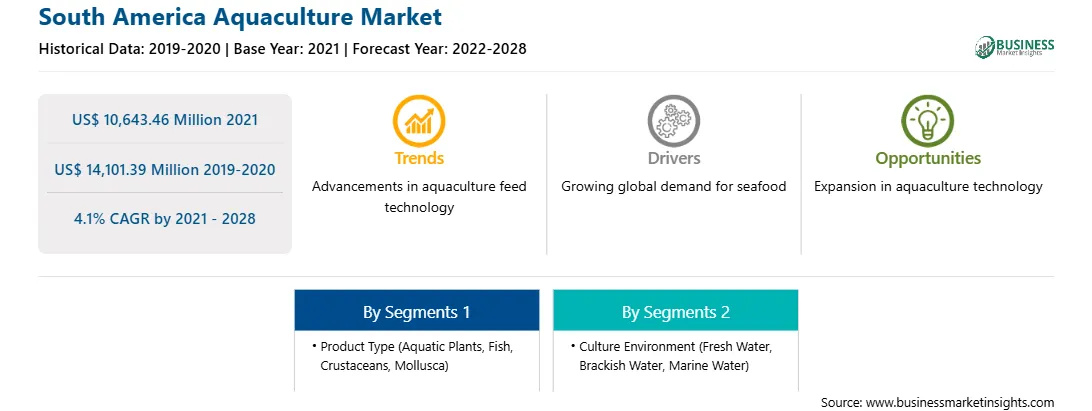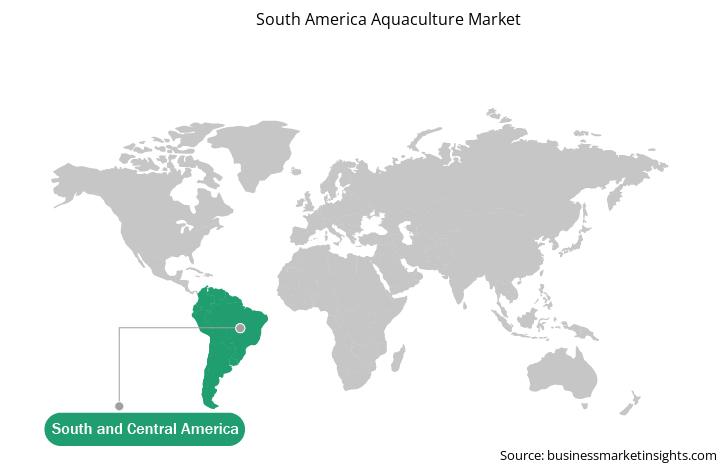Seafood, specifically fish, is part of traditional food in many regions. Also, fish is largely consumed owing to its nutritional benefits and several health benefits. It is considered a good source of fatty acids, vitamins, minerals, protein, and essential micronutrients. An increase in disposable income and spending power of consumers encourage them to spend on animal proteins such as seafood. Currently, high growth in population and increased popularity of seafood as a healthy source of protein have fueled the growth of the aquaculture market. Wild fisheries are not sufficient to meet the total seafood demand generated in SAM, and the issue can be addressed by acquiring aquaculture practices. Aquaculture is the practice of farming aquatic animals such as fish, crustaceans, and mollusks in a controlled environment in man-made tanks and ponds, or water bodies in coastal areas. The yield of aquaculture accounts for more than half of the seafood consumption across the region. Overfishing in the oceans has created a need for the development of alternative methods for the production of seafood. Aquaculture is a sustainable solution that has emerged as an environmentally friendly alternative to wild fishing. It is the controlled process of farming aquatic organisms in inland and coastal areas. Aquaculture is carried out by multinational companies as well as small-scale fisheries. Also, the Food and Agriculture Organization (FAO) has predicted that fish consumption by humans is expected to increase by 50% in the next 15 years.
Brazil has reported the highest number of COVID-19 confirmed cases in SAM, followed by Argentina, Peru, Chile, and Ecuador. Governments have taken several actions to protect their citizens and contain the spread of SARS-CoV-2. Containment measures in several SAM countries reduced economic activity in the manufacturing sector in 2020. However, as the economies are recovering from losses, the aquaculture market is also projected to witness resurgence in the next few years. Moreover, with the growing demand for seafood from both the food retail and foodservice sector in the region, the aquaculture market is projected to grow at a notable pace during the forecast period.
With the new features and technologies, vendors can attract new customers and expand their footprints in emerging markets. This factor is likely to drive the SAM aquaculture market at a good CAGR during the forecast period.
SAM Aquaculture Market Segmentation
Strategic insights for the South America Aquaculture provides data-driven analysis of the industry landscape, including current trends, key players, and regional nuances. These insights offer actionable recommendations, enabling readers to differentiate themselves from competitors by identifying untapped segments or developing unique value propositions. Leveraging data analytics, these insights help industry players anticipate the market shifts, whether investors, manufacturers, or other stakeholders. A future-oriented perspective is essential, helping stakeholders anticipate market shifts and position themselves for long-term success in this dynamic region. Ultimately, effective strategic insights empower readers to make informed decisions that drive profitability and achieve their business objectives within the market.

| Report Attribute | Details |
|---|---|
| Market size in 2021 | US$ 10,643.46 Million |
| Market Size by 2028 | US$ 14,101.39 Million |
| Global CAGR (2021 - 2028) | 4.1% |
| Historical Data | 2019-2020 |
| Forecast period | 2022-2028 |
| Segments Covered |
By Product Type
|
| Regions and Countries Covered | South and Central America
|
| Market leaders and key company profiles |
The geographic scope of the South America Aquaculture refers to the specific areas in which a business operates and competes. Understanding local distinctions, such as diverse consumer preferences (e.g., demand for specific plug types or battery backup durations), varying economic conditions, and regulatory environments, is crucial for tailoring strategies to specific markets. Businesses can expand their reach by identifying underserved areas or adapting their offerings to meet local demands. A clear market focus allows for more effective resource allocation, targeted marketing campaigns, and better positioning against local competitors, ultimately driving growth in those targeted areas.

The South America Aquaculture Market is valued at US$ 10,643.46 Million in 2021, it is projected to reach US$ 14,101.39 Million by 2028.
As per our report South America Aquaculture Market, the market size is valued at US$ 10,643.46 Million in 2021, projecting it to reach US$ 14,101.39 Million by 2028. This translates to a CAGR of approximately 4.1% during the forecast period.
The South America Aquaculture Market report typically cover these key segments-
The historic period, base year, and forecast period can vary slightly depending on the specific market research report. However, for the South America Aquaculture Market report:
The South America Aquaculture Market is populated by several key players, each contributing to its growth and innovation. Some of the major players include:
The South America Aquaculture Market report is valuable for diverse stakeholders, including:
Essentially, anyone involved in or considering involvement in the South America Aquaculture Market value chain can benefit from the information contained in a comprehensive market report.